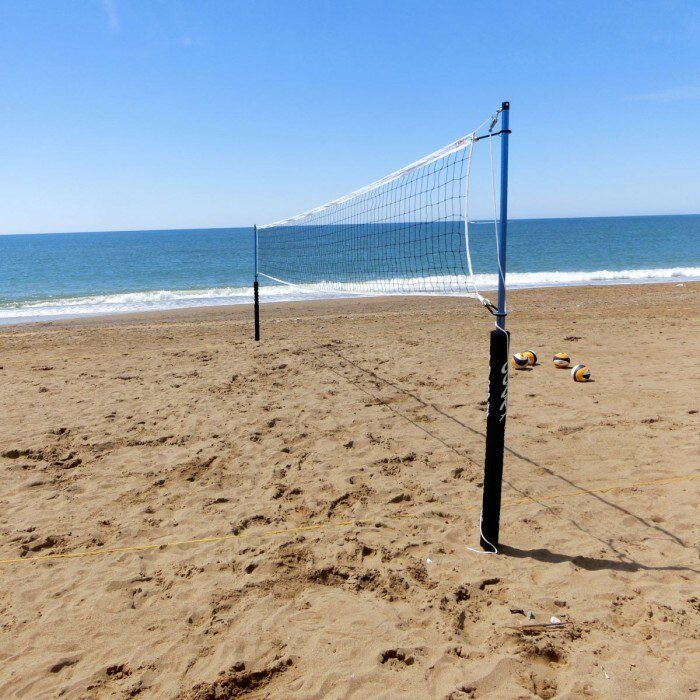A volleyball court requires proper nets and posts both during competitive matches as well as casual beach volleyball games. The quality of equipment determines both gameplay performance and player security as well as game quality altogether. Here is the guide on how to choose the best volleyball nets and poles, especially focusing on special beach volleyball nets:
Types of Volleyball Nets and Posts:
1.Indoor Volleyball Nets and Posts Material: durable synthetic fibres like nylon Posts: often anchored on the ground for tension systems.
Usage: Fit for school, gym or professional tournaments indoor.
2.Outdoors Volleyball Nets Built to last: made from materials UV resistant. Versatile Setup: can be used in grass or hard courts.
3.Beach Volleyball Nets Sand-Ready Design: Lightweight and corrosion-resistant.
4.Customized Dimension: 8.5m wide and slightly different height for competition of men’s and women’s. Bright Colors: For Very High Visibility Under Sunlight.
Must Include Attributes While Shopping for Volleyball Nets and Posts:
Very common these days, especially with beach volleyball nets.
✅Weather-worn – critical, especially with outdoor and beach volleyball nets.
✅Portability-the option between nets collapsible posts as well as associated carrying bags.
✅Adjustability-highly recommend for varying net height depending on the level of players. ✅Durability-would come in not-so-easy-to-tear mesh nets. Conformity: Sizes, and materials approved by the FIVB set up fair play.
How to Choose the Right Net
Not all nets are going to give the same performance. Your selection depends upon the environment and level of play.
For Schools & Community Centres: Do- it-yourself cost-effective indoor nets without posts for height adjustment.
For Professional Tournaments: FIVB approved systems with tensioning mechanisms are required.
For Beach Only Use: Lightweight, portable systems, anti corrosion features should be primary.
The Uniqueness of Beach Volleyball Nets
Beach volleyball nets are designed for the specification of sand play in general:
Anchoring System: It needs sand specific ground plates or stakes.
Height & Tensioning: Wind condition and uneven surface must have stability.
Material: Required UV-treated and waterproof and rust proof.
Design: Bold colors and thicker bands increase visibility with sunlight and sand backgrounds.
How Should Installation Be Done
Proper setting up of your volleyball nets and posts is very important for safety and performance.
Indoor
Secure to built-in post sleeves or secured directly through floor anchors.
Straight: crank or ropes to adjust tension.
Outdoor/Grass
Weight bases or ground stakes.
Sturdy and upright before tensioning the net.
Beach
Sand anchors or deep stakes.
Uplift the sand beneath the posts for a level net height.
Regular check against sagging due to shifting sands.
Maintenance and Storage Considerations
Having a well-maintained net accurately translates to long life span:
🧼 After using beach nets, rinse them thoroughly with fresh water, removing as much sand and salt as possible.
☀️ Ensure that beach nets are completely dry before storing, as moisture can create conditions conducive to mold and decay.
📦 Store your nets in a carry bag or a dry container, especially off-season.
🔍 Before using any nets, inspect the nets for any frayed edges, rusty hardware, or worn-out straps.
Where to Get Volleyball Nets and Posts
Quality volleyball nets and posts can be found at:
✅ Sporting goods stores
✅ Specialised online retailers
✅ Manufacturers’ direct sales, in case of bulk or tournament orders
Check the reviews of each product, check for warranties and regulation sizes.
Conclusion
A player’s level of competition will influence their decision regarding volleyball nets and posts but these components directly affect gameplay success. Your beach volleyball game will improve significantly through the use of robust yet easily assembled beach volleyball nets built for sand use. Remember to keep quality, stability, and ease of use in the forefront-and let the games begin!
